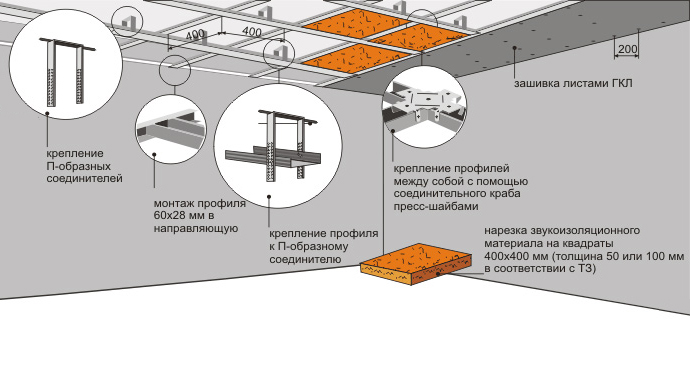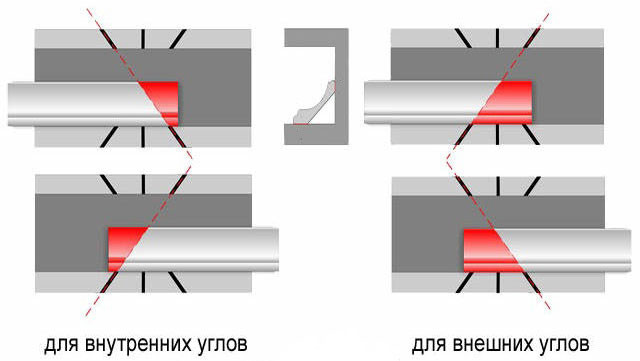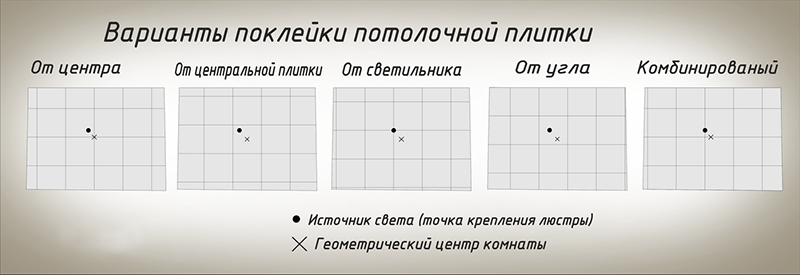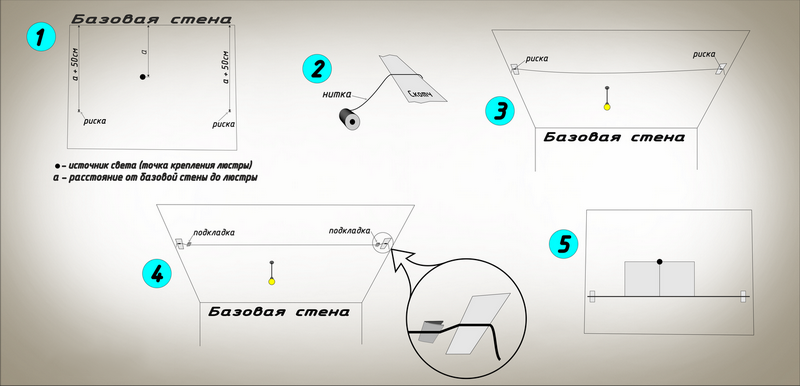От того, каким будет потолок, зависит многое.Often it is the ceiling covering that sets the main tone of the entire decoration, creating a bright and beautiful interior. Among the numerous design options, gypsum tiles stand out, giving the room a special chic and sophistication. The cost of ready-made gypsum tiles is high, but you can easily make them yourself, for which it is enough to buy relatively inexpensive silicone molds with the desired pattern. Such a gypsum ceiling is painted after installation, but not completely, and only the ornament is highlighted with colored paints. Installation diagram of a plaster ceiling.
Installation diagram of a plaster ceiling.
Ceiling tiles and plinth of plaster with their own hands
Ceiling tiles are made usingspecial silicone molds and dry gypsum mix. Today, molds can be purchased in construction stores or ordered, but in the second case, their cost will be much higher. Some home craftsmen cast such molds themselves, but this process requires experience. Ceiling tiles and skirting boards made of gypsum are not so difficult to make, but it is necessary to provide reinforcement for each tile so that it does not crumble or crack during use. For this, special silicone molds are used, which are filled with gypsum mass. The process of making the skirting board is as follows: Ceiling plinth cutting diagram.
Ceiling plinth cutting diagram.
Return to Contents</a>
Mounting the stucco with your own hands
To lay gypsum tiles on the ceiling, you need to take the following tools and materials:
- tape measure, metal long ruler;
- a simple pencil;
- building level;
- brush;
- thin twine;
- flexible spatula;
- Manual saws for cutting tiles;
- sandpaper, so that the end parts can be cleaned after cutting.
 Tools for installing gypsum tiles.You will need the tile itself in the calculated quantity (depending on the shape and size), a plinth, and glue. You should use a special glue for artificial stone, which can easily withstand the weight of such cladding. You should start gluing by inspecting the ceiling. It should be smooth, cleared of the old coating, so that the tile does not fall off over time. It is best to glue it to a base cleared of plaster, concrete, slabs, or plasterboard. After that, the surface is treated with a deep penetration primer. This ensures better adhesion. The markings are made in such a way that gluing starts from the central point of the ceiling. Much depends on the shape of the tile, but for a regular square tile there should be no problems. It is important that the cutting is done symmetrically, otherwise the pattern will not be the best. The glue is mixed in small quantities, as it sets quickly. The solution is applied with a spatula to the back of each tile, after which it is pressed tightly to the surface for 2 seconds. If glue protrudes between the joints, it must be carefully removed, as it will be difficult to do later. After finishing the entire ceiling, you need to start gluing the skirting boards along the perimeter. It is important not to forget about the skirting boards when laying the tiles, and leave the necessary space for their subsequent installation. Return to contents</a>
Tools for installing gypsum tiles.You will need the tile itself in the calculated quantity (depending on the shape and size), a plinth, and glue. You should use a special glue for artificial stone, which can easily withstand the weight of such cladding. You should start gluing by inspecting the ceiling. It should be smooth, cleared of the old coating, so that the tile does not fall off over time. It is best to glue it to a base cleared of plaster, concrete, slabs, or plasterboard. After that, the surface is treated with a deep penetration primer. This ensures better adhesion. The markings are made in such a way that gluing starts from the central point of the ceiling. Much depends on the shape of the tile, but for a regular square tile there should be no problems. It is important that the cutting is done symmetrically, otherwise the pattern will not be the best. The glue is mixed in small quantities, as it sets quickly. The solution is applied with a spatula to the back of each tile, after which it is pressed tightly to the surface for 2 seconds. If glue protrudes between the joints, it must be carefully removed, as it will be difficult to do later. After finishing the entire ceiling, you need to start gluing the skirting boards along the perimeter. It is important not to forget about the skirting boards when laying the tiles, and leave the necessary space for their subsequent installation. Return to contents</a>
Variety of gypsum boards
The plaster ceiling amazes with its diversity.This is not necessarily a regular tile, often complex suspended structures, modular ceilings are used, for the installation of which the presence of a master is already required. But regular gypsum tiles can completely transform any interior, make it more stylish, luxurious, elegant. For this, slabs of various models are used, among which are: Scheme of a two-level plaster ceiling.
Scheme of a two-level plaster ceiling.
Return to Contents</a>
Seamless ceiling tiles: imitation of plaster moldings
 Options for gluing ceiling tiles.Gypsum, despite all its advantages, has several disadvantages, which are sometimes significant. This is the cost of the tile or the time and experience for its manufacture, the large weight of the cladding. But there is a way out of this situation, a do-it-yourself ceiling with imitation gypsum can be easily made from seamless polystyrene foam tiles. This is a beautiful product with figured edges, imitating the surface of natural stucco. It has beautiful figured edges that allow you to join the coating without seams. The pattern can be different, after gluing the tile is easily painted in the desired color. Polystyrene gypsum tiles are produced in the form of thin plates with a thickness of 5 mm and dimensions of 50 * 50 cm. One package is usually enough to cover about 1 m². Among the advantages, it is necessary to note:
Options for gluing ceiling tiles.Gypsum, despite all its advantages, has several disadvantages, which are sometimes significant. This is the cost of the tile or the time and experience for its manufacture, the large weight of the cladding. But there is a way out of this situation, a do-it-yourself ceiling with imitation gypsum can be easily made from seamless polystyrene foam tiles. This is a beautiful product with figured edges, imitating the surface of natural stucco. It has beautiful figured edges that allow you to join the coating without seams. The pattern can be different, after gluing the tile is easily painted in the desired color. Polystyrene gypsum tiles are produced in the form of thin plates with a thickness of 5 mm and dimensions of 50 * 50 cm. One package is usually enough to cover about 1 m². Among the advantages, it is necessary to note:
- Low cost when getting a stylish surface;
- resistance to flame and sudden temperature rises;
- resistance to moisture;
- excellent sound insulation and thermal insulation;
- practicality;
- extremely simple installation - the tile is glued to the surface;
- the possibility of painting the ceiling after its installation.
 Scheme of preparing the ceiling for gluing tiles.In order for the ceiling to be beautiful, it is necessary to carefully buy tiles with imitation of gypsum stucco. Often there are not very high-quality examples that have depressions on the surface, lack of smoothness. Such tiles are clearly not worth buying. It is also important to pay attention to the quality of the edges. It is the joint that ensures seamlessness, complete masking of the joints. If the edges are uneven, do not match, then you should not take such tiles, their quality is not very good. Return to the table of contents</a>
Scheme of preparing the ceiling for gluing tiles.In order for the ceiling to be beautiful, it is necessary to carefully buy tiles with imitation of gypsum stucco. Often there are not very high-quality examples that have depressions on the surface, lack of smoothness. Such tiles are clearly not worth buying. It is also important to pay attention to the quality of the edges. It is the joint that ensures seamlessness, complete masking of the joints. If the edges are uneven, do not match, then you should not take such tiles, their quality is not very good. Return to the table of contents</a>
How does the tile fit?
Installation of tiles with imitation of gypsumthe surface is simple, you just need to first correctly determine its quantity, and then apply markings to the ceiling. You will have to consider whether trimming is necessary, how exactly and where such parts of the tiles will be located so that the coating as a whole looks beautiful. If there is a pattern on the front surface that you want to paint, it is easier to do this before the moment the tile is glued to the ceiling. It is best to use acrylic paints for painting. You should paint carefully and with a thin brush. The coating should be glued only to a flat ceiling, plasterboard is best suited, it must be covered with a layer of primer before gluing. The tile itself should be kept open for about a day in the room where it will be glued. You need to start working from the center, the glue is applied to the ceiling and to the tile in a thin layer, after which the material is pressed to the surface for 1-2 seconds. You cannot press hard, as the tile will break. If glue comes out between the joints during installation, it must be removed immediately before it dries, since it will be problematic to remove such residues later. Plaster ceiling decoration has always been carried out in ceremonial halls, large and elegant living rooms, and bedrooms. The peculiarity of such decoration is that the ceilings must be high enough, especially for complex structures that can consist of several levels. If ordinary tiles are used for decoration, then it is quite possible to do it yourself, but for ceremonial painted ceilings, the hand of a real master is clearly required. It is necessary to strictly follow the technology, properly prepare the ceiling for work. If there are no conditions for using gypsum tiles, then you can use an excellent polystyrene imitation of stucco - the most beautiful seamless ceiling.


